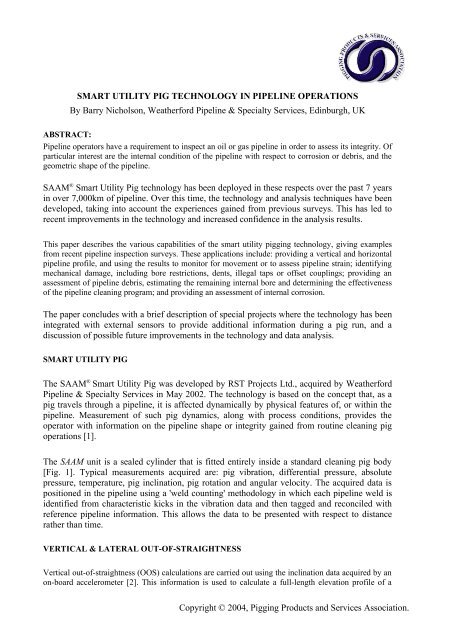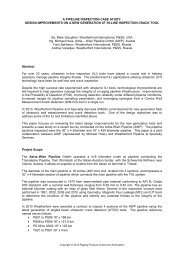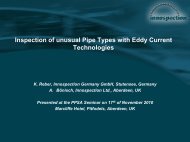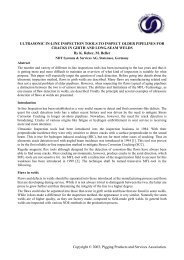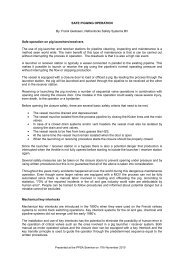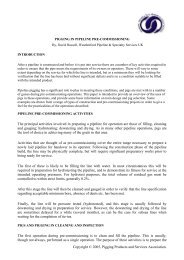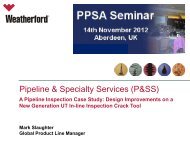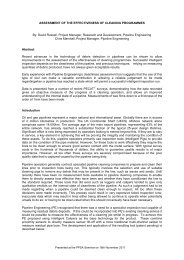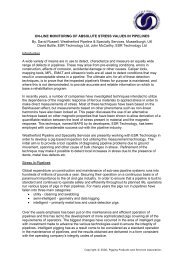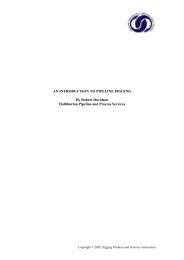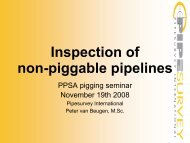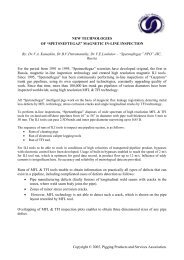smart utility pig technology in pipeline operations - PPSA, the ...
smart utility pig technology in pipeline operations - PPSA, the ...
smart utility pig technology in pipeline operations - PPSA, the ...
Create successful ePaper yourself
Turn your PDF publications into a flip-book with our unique Google optimized e-Paper software.
SMART UTILITY PIG TECHNOLOGY IN PIPELINE OPERATIONS<br />
By Barry Nicholson, Wea<strong>the</strong>rford Pipel<strong>in</strong>e & Specialty Services, Ed<strong>in</strong>burgh, UK<br />
ABSTRACT:<br />
Pipel<strong>in</strong>e operators have a requirement to <strong>in</strong>spect an oil or gas pipel<strong>in</strong>e <strong>in</strong> order to assess its <strong>in</strong>tegrity. Of<br />
particular <strong>in</strong>terest are <strong>the</strong> <strong>in</strong>ternal condition of <strong>the</strong> pipel<strong>in</strong>e with respect to corrosion or debris, and <strong>the</strong><br />
geometric shape of <strong>the</strong> pipel<strong>in</strong>e.<br />
SAAM ® Smart Utility Pig <strong>technology</strong> has been deployed <strong>in</strong> <strong>the</strong>se respects over <strong>the</strong> past 7 years<br />
<strong>in</strong> over 7,000km of pipel<strong>in</strong>e. Over this time, <strong>the</strong> <strong>technology</strong> and analysis techniques have been<br />
developed, tak<strong>in</strong>g <strong>in</strong>to account <strong>the</strong> experiences ga<strong>in</strong>ed from previous surveys. This has led to<br />
recent improvements <strong>in</strong> <strong>the</strong> <strong>technology</strong> and <strong>in</strong>creased confidence <strong>in</strong> <strong>the</strong> analysis results.<br />
This paper describes <strong>the</strong> various capabilities of <strong>the</strong> <strong>smart</strong> <strong>utility</strong> <strong>pig</strong>g<strong>in</strong>g <strong>technology</strong>, giv<strong>in</strong>g examples<br />
from recent pipel<strong>in</strong>e <strong>in</strong>spection surveys. These applications <strong>in</strong>clude: provid<strong>in</strong>g a vertical and horizontal<br />
pipel<strong>in</strong>e profile, and us<strong>in</strong>g <strong>the</strong> results to monitor for movement or to assess pipel<strong>in</strong>e stra<strong>in</strong>; identify<strong>in</strong>g<br />
mechanical damage, <strong>in</strong>clud<strong>in</strong>g bore restrictions, dents, illegal taps or offset coupl<strong>in</strong>gs; provid<strong>in</strong>g an<br />
assessment of pipel<strong>in</strong>e debris, estimat<strong>in</strong>g <strong>the</strong> rema<strong>in</strong><strong>in</strong>g <strong>in</strong>ternal bore and determ<strong>in</strong><strong>in</strong>g <strong>the</strong> effectiveness<br />
of <strong>the</strong> pipel<strong>in</strong>e clean<strong>in</strong>g program; and provid<strong>in</strong>g an assessment of <strong>in</strong>ternal corrosion.<br />
The paper concludes with a brief description of special projects where <strong>the</strong> <strong>technology</strong> has been<br />
<strong>in</strong>tegrated with external sensors to provide additional <strong>in</strong>formation dur<strong>in</strong>g a <strong>pig</strong> run, and a<br />
discussion of possible future improvements <strong>in</strong> <strong>the</strong> <strong>technology</strong> and data analysis.<br />
SMART UTILITY PIG<br />
The SAAM ® Smart Utility Pig was developed by RST Projects Ltd., acquired by Wea<strong>the</strong>rford<br />
Pipel<strong>in</strong>e & Specialty Services <strong>in</strong> May 2002. The <strong>technology</strong> is based on <strong>the</strong> concept that, as a<br />
<strong>pig</strong> travels through a pipel<strong>in</strong>e, it is affected dynamically by physical features of, or with<strong>in</strong> <strong>the</strong><br />
pipel<strong>in</strong>e. Measurement of such <strong>pig</strong> dynamics, along with process conditions, provides <strong>the</strong><br />
operator with <strong>in</strong>formation on <strong>the</strong> pipel<strong>in</strong>e shape or <strong>in</strong>tegrity ga<strong>in</strong>ed from rout<strong>in</strong>e clean<strong>in</strong>g <strong>pig</strong><br />
<strong>operations</strong> [1].<br />
The SAAM unit is a sealed cyl<strong>in</strong>der that is fitted entirely <strong>in</strong>side a standard clean<strong>in</strong>g <strong>pig</strong> body<br />
[Fig. 1]. Typical measurements acquired are: <strong>pig</strong> vibration, differential pressure, absolute<br />
pressure, temperature, <strong>pig</strong> <strong>in</strong>cl<strong>in</strong>ation, <strong>pig</strong> rotation and angular velocity. The acquired data is<br />
positioned <strong>in</strong> <strong>the</strong> pipel<strong>in</strong>e us<strong>in</strong>g a 'weld count<strong>in</strong>g' methodology <strong>in</strong> which each pipel<strong>in</strong>e weld is<br />
identified from characteristic kicks <strong>in</strong> <strong>the</strong> vibration data and <strong>the</strong>n tagged and reconciled with<br />
reference pipel<strong>in</strong>e <strong>in</strong>formation. This allows <strong>the</strong> data to be presented with respect to distance<br />
ra<strong>the</strong>r than time.<br />
VERTICAL & LATERAL OUT-OF-STRAIGHTNESS<br />
Vertical out-of-straightness (OOS) calculations are carried out us<strong>in</strong>g <strong>the</strong> <strong>in</strong>cl<strong>in</strong>ation data acquired by an<br />
on-board accelerometer [2]. This <strong>in</strong>formation is used to calculate a full-length elevation profile of a<br />
Copyright © 2004, Pigg<strong>in</strong>g Products and Services Association.
pipel<strong>in</strong>e from which local vertical OOS features are identified and profiled. Local features identified<br />
typically have a change <strong>in</strong> elevation of >0.5m over a distance
An <strong>in</strong>spection was carried out <strong>in</strong> a 12" onshore gas pipel<strong>in</strong>e with <strong>the</strong> objective of identify<strong>in</strong>g<br />
suspected locations of 'black power' form<strong>in</strong>g on <strong>the</strong> pipe wall. Two successive <strong>in</strong>spections were<br />
carried out, with both sets of result<strong>in</strong>g data analysed toge<strong>the</strong>r. Through comparison of <strong>the</strong> two<br />
datasets, permanent bore restrictions were identified such as <strong>in</strong>l<strong>in</strong>e components or <strong>in</strong>creased<br />
wall thickness sections. These were differentiated from bore restrictions caused by debris,<br />
which only occurred <strong>in</strong> one or o<strong>the</strong>r of <strong>the</strong> two surveys. This analysis highlighted to <strong>the</strong> client<br />
locations of<br />
suspected black powder formation on <strong>the</strong> <strong>in</strong>ner pipe wall [Fig. 6]. In addition, <strong>the</strong> relatively<br />
clean appearance of <strong>the</strong> pipel<strong>in</strong>e <strong>in</strong> <strong>the</strong> second <strong>in</strong>spection provided <strong>in</strong>formation to <strong>the</strong> operator<br />
on <strong>the</strong><br />
effectiveness of <strong>the</strong> clean<strong>in</strong>g <strong>pig</strong>, <strong>in</strong>dicat<strong>in</strong>g that <strong>the</strong> debris was removed relatively easily by a<br />
s<strong>in</strong>gle <strong>pig</strong> run.<br />
Monitor<strong>in</strong>g of wax deposits <strong>in</strong> an offshore 16" oil pipel<strong>in</strong>e has been carried out by 6<br />
<strong>in</strong>spections over 3 years. Wax formation <strong>in</strong> this pipel<strong>in</strong>e has been identified by very<br />
characteristic data traces result<strong>in</strong>g <strong>in</strong> isolated anomalies <strong>in</strong> vibration and differential pressure.<br />
The rate of occurrence and magnitude of <strong>the</strong>se anomalies reflects <strong>the</strong> severity of <strong>the</strong> wax<br />
formation. In general, wax formation anomalies are observed <strong>in</strong> <strong>the</strong> same general region of a<br />
pipel<strong>in</strong>e over different <strong>in</strong>spections, but <strong>in</strong>dividual anomalies do not re-occur at <strong>the</strong> same<br />
locations. Hard wax was also identified <strong>in</strong> this pipel<strong>in</strong>e downstream of <strong>the</strong> wax formation zone<br />
result<strong>in</strong>g <strong>in</strong> large peaks <strong>in</strong> differential pressure, over several kilometres due to <strong>the</strong> bore<br />
restriction caused by <strong>the</strong> wax. A decrease <strong>in</strong> vibration levels was also observed, along with a<br />
reduction <strong>in</strong> <strong>the</strong> kicks normally seen at welds, due to <strong>the</strong> wax limit<strong>in</strong>g <strong>the</strong> <strong>pig</strong>'s contact with <strong>the</strong><br />
pipe wall. The results of <strong>the</strong>se <strong>in</strong>spections have been used by <strong>the</strong> operator of this pipel<strong>in</strong>e to<br />
track <strong>the</strong> extents of wax formation and hard wax zones over time [Fig. 7].<br />
An <strong>in</strong>spection of a 12" deepwater gas pipel<strong>in</strong>e was carried out to assess <strong>the</strong> amount of debris enter<strong>in</strong>g<br />
<strong>the</strong> pipel<strong>in</strong>e from several well tie-<strong>in</strong> po<strong>in</strong>ts along its length. The data around each tie-<strong>in</strong> po<strong>in</strong>t was<br />
analysed and an assessment provided to <strong>the</strong> operator of <strong>the</strong> nature of any debris occurr<strong>in</strong>g downstream<br />
of any of <strong>the</strong>se po<strong>in</strong>ts [Fig. 8]. The results were correlated with <strong>the</strong> pipel<strong>in</strong>e elevation profile and<br />
showed that <strong>in</strong> some locations, debris was accumulat<strong>in</strong>g at elevation low spots <strong>in</strong> <strong>the</strong> pipel<strong>in</strong>e<br />
immediately downstream of <strong>the</strong> well locations.<br />
BORE RESTRICTIONS<br />
Bore restrictions <strong>in</strong> pipel<strong>in</strong>es, ei<strong>the</strong>r <strong>in</strong>l<strong>in</strong>e components or mechanical damage, have been<br />
identified and located through analysis of <strong>the</strong> vibration and differential pressure data acquired<br />
dur<strong>in</strong>g SAAM <strong>in</strong>spections. Differential pressure is measured across <strong>the</strong> carrier <strong>pig</strong> body and<br />
experiences an <strong>in</strong>creased read<strong>in</strong>g when an <strong>in</strong>creased force is required to push <strong>the</strong> <strong>pig</strong> past an<br />
<strong>in</strong>ternal bore restriction, such as a valve, bend, dent or debris. Such restrictions can also affect<br />
<strong>the</strong> <strong>pig</strong> vibration along with <strong>the</strong> o<strong>the</strong>r data logged.<br />
Smart <strong>utility</strong> <strong>pig</strong>s have been used analyse <strong>the</strong> passage of a clean<strong>in</strong>g <strong>pig</strong> through <strong>in</strong>l<strong>in</strong>e components to<br />
<strong>in</strong>vestigate damage to <strong>pig</strong>s noted dur<strong>in</strong>g clean<strong>in</strong>g <strong>operations</strong>, or <strong>in</strong> recently acquired or constructed<br />
pipel<strong>in</strong>es to ensure a clean passage of <strong>the</strong> <strong>pig</strong> through <strong>in</strong>l<strong>in</strong>e components. An <strong>in</strong>spection of a recently<br />
constructed 12" offshore oil pipel<strong>in</strong>e <strong>in</strong> 2003 was carried out to confirm to <strong>the</strong> operator that clean<strong>in</strong>g<br />
<strong>pig</strong>s could pass through <strong>the</strong> various <strong>in</strong>l<strong>in</strong>e components without difficulty, <strong>in</strong> particular at a <strong>pig</strong>g<strong>in</strong>g<br />
jumper at <strong>the</strong> end of two flowl<strong>in</strong>es. The data acquired dur<strong>in</strong>g <strong>the</strong> <strong>in</strong>spection confirmed that <strong>the</strong> <strong>pig</strong><br />
passed through <strong>the</strong>se components without becom<strong>in</strong>g held up, and no anomalous differential pressure<br />
Copyright © 2004, Pigg<strong>in</strong>g Products and Services Association.
ead<strong>in</strong>gs were noted. However, on several occasions <strong>in</strong> o<strong>the</strong>r pipel<strong>in</strong>es, data analysis has identified<br />
<strong>in</strong>stances of a clean<strong>in</strong>g <strong>pig</strong> becom<strong>in</strong>g held up at restrictions caused by <strong>in</strong>l<strong>in</strong>e components. Such features<br />
typically result <strong>in</strong> a gradual build up <strong>in</strong> differential pressure across <strong>the</strong> <strong>pig</strong> body, dropp<strong>in</strong>g sharply as <strong>the</strong><br />
<strong>pig</strong> clears <strong>the</strong> restriction [Fig. 9].<br />
Data acquired by <strong>smart</strong> <strong>utility</strong> <strong>pig</strong>s has also been used to identify bore restrictions caused by pipel<strong>in</strong>e<br />
damage [4]. This could be a dent, flat spot or illegal tap. The operator of an 18" onshore gas pipel<strong>in</strong>e<br />
was concerned that some dresser coupl<strong>in</strong>gs situated after every third spool <strong>in</strong> <strong>the</strong> pipel<strong>in</strong>e may have<br />
become misaligned. After two successive <strong>in</strong>spection runs, each coupl<strong>in</strong>g was identified by a larger than<br />
normal vibration kick and an anomalous angular velocity read<strong>in</strong>g. Several coupl<strong>in</strong>gs were highlighted<br />
and positioned where <strong>the</strong> <strong>pig</strong> became held up and stopped momentarily due to a restriction [Fig. 10].<br />
This allowed <strong>the</strong> operator to locate and assess each feature <strong>in</strong>dividually.<br />
Bore restrictions can also occur due to debris build-up on <strong>the</strong> <strong>in</strong>ternal pipe wall such as hard wax, scale<br />
or hydrates. Smart <strong>utility</strong> <strong>pig</strong>s cannot provide a direct measurement of <strong>the</strong> magnitude of <strong>the</strong> restriction.<br />
However <strong>in</strong> some cases, where several different references exist of known <strong>in</strong>ternal bores <strong>in</strong> a pipel<strong>in</strong>e,<br />
<strong>the</strong> differential pressure read<strong>in</strong>gs at such known bore restrictions have used to calculate a best-fit curve<br />
of differential pressure aga<strong>in</strong>st rema<strong>in</strong><strong>in</strong>g <strong>in</strong>ternal bore. This was used <strong>in</strong> a 12" offshore oil pipel<strong>in</strong>e to<br />
estimate <strong>the</strong> bore restrictions caused by debris attached to <strong>the</strong> pipe wall at several locations along <strong>the</strong><br />
pipel<strong>in</strong>e [Fig. 11]. Although <strong>the</strong> result<strong>in</strong>g values were not considered highly accurate, <strong>the</strong>y were<br />
considered adequate to satisfy <strong>the</strong> operator that <strong>the</strong> debris did not cause a significant bore restriction.<br />
CORROSION ASSESSMENT<br />
Experience ga<strong>in</strong>ed over recent years has improved <strong>the</strong> capabilities of corrosion assessment us<strong>in</strong>g <strong>the</strong><br />
data acquired by <strong>smart</strong> <strong>utility</strong> <strong>pig</strong>s. This assessment is based on <strong>the</strong> concept that corrosion results <strong>in</strong> a<br />
generally <strong>in</strong>creased surface roughness of <strong>the</strong> <strong>in</strong>ternal pipe wall, and this is manifested <strong>in</strong> an <strong>in</strong>creased<br />
<strong>pig</strong> vibration as it passes through a corroded region, reflected <strong>in</strong> <strong>the</strong> vibration data [5]. Pig vibration is<br />
also affected by several o<strong>the</strong>r factors, <strong>the</strong>refore two successive <strong>in</strong>spections are normally carried out and<br />
analysed toge<strong>the</strong>r <strong>in</strong> order to elim<strong>in</strong>ate <strong>the</strong> effects of debris, velocity excursions or o<strong>the</strong>r transient<br />
features from <strong>the</strong> data.<br />
A corrosion assessment <strong>in</strong>spection of a 16" offshore oil pipel<strong>in</strong>e was carried out <strong>in</strong> 2003. A previous<br />
<strong>in</strong>telligent <strong>pig</strong> <strong>in</strong>spection identified corrosion across <strong>the</strong> first 1000m of <strong>the</strong> pipel<strong>in</strong>e. However, <strong>the</strong><br />
presence of wax <strong>in</strong> <strong>the</strong> pipel<strong>in</strong>e at <strong>the</strong> time of <strong>the</strong> <strong>in</strong>telligent <strong>pig</strong> survey resulted <strong>in</strong> no data be<strong>in</strong>g<br />
acquired for <strong>the</strong> rema<strong>in</strong>der of <strong>the</strong> pipel<strong>in</strong>e, and <strong>the</strong> operator was concerned that <strong>the</strong> corrosion may<br />
extend fur<strong>the</strong>r downstream. The vibration data acquired <strong>in</strong> <strong>the</strong> two SAAM <strong>in</strong>spections was analysed <strong>in</strong><br />
order to elim<strong>in</strong>ate transient effects and identify permanent anomalies most likely to be <strong>in</strong>dicative of<br />
corrosion. These were compared with <strong>the</strong> results of <strong>the</strong> <strong>in</strong>telligent <strong>pig</strong> <strong>in</strong>spection to determ<strong>in</strong>e <strong>the</strong><br />
characteristic vibration signal at regions of corrosion. A strong correlation was identified between<br />
clusters of metal loss features identified by <strong>the</strong> <strong>in</strong>telligent <strong>pig</strong>, and <strong>in</strong>creased <strong>smart</strong> <strong>utility</strong> <strong>pig</strong> vibration<br />
[Fig. 12]. The elevation profile of <strong>the</strong> pipel<strong>in</strong>e, calculated from <strong>the</strong> <strong>in</strong>cl<strong>in</strong>ation data, also highlighted a<br />
correlation between <strong>the</strong> locations of corrosion and elevation low spots <strong>in</strong> this region [Fig. 13]. The<br />
<strong>in</strong>formation ga<strong>in</strong>ed on <strong>the</strong> type of vibration signal <strong>in</strong>dicative of corrosion at <strong>the</strong> beg<strong>in</strong>n<strong>in</strong>g of <strong>the</strong><br />
pipel<strong>in</strong>e allowed <strong>the</strong> vibration data for <strong>the</strong> rema<strong>in</strong>der of <strong>the</strong> pipel<strong>in</strong>e to be analysed for fur<strong>the</strong>r<br />
anomalies <strong>in</strong>dicative of corrosion. This analysis confirmed to <strong>the</strong> operator that no significant corrosion<br />
occurred later <strong>in</strong> <strong>the</strong> pipel<strong>in</strong>e, and also provided a basel<strong>in</strong>e of <strong>the</strong> pipel<strong>in</strong>e's <strong>in</strong>ternal condition aga<strong>in</strong>st<br />
which to compare <strong>the</strong> data from future <strong>in</strong>spections, <strong>in</strong> order to monitor for <strong>in</strong>creases <strong>in</strong> corrosion.<br />
CONCLUSIONS & FUTURE DEVELOPMENTS<br />
Recent projects have shown <strong>smart</strong> <strong>utility</strong> <strong>pig</strong> <strong>technology</strong> be<strong>in</strong>g used as an effective tool for monitor<strong>in</strong>g a<br />
pipel<strong>in</strong>e's shape and <strong>in</strong>ternal condition. It is also used <strong>in</strong>creas<strong>in</strong>gly as a method of provid<strong>in</strong>g a basel<strong>in</strong>e,<br />
both for shape and condition, of a newly constructed pipel<strong>in</strong>e to provide a basis for comparison aga<strong>in</strong>st<br />
future <strong>in</strong>spections dur<strong>in</strong>g <strong>the</strong> length of <strong>the</strong> pipel<strong>in</strong>e.<br />
Copyright © 2004, Pigg<strong>in</strong>g Products and Services Association.
For recent special projects <strong>the</strong> <strong>smart</strong> <strong>utility</strong> <strong>pig</strong> <strong>technology</strong> has been extended to <strong>in</strong>clude external<br />
odometers, liquid sensors or caliper arms. The data logged from <strong>the</strong>se sensors were analysed along with<br />
data measured by <strong>the</strong> standard <strong>in</strong>strumentation. This <strong>in</strong>cluded comb<strong>in</strong><strong>in</strong>g <strong>the</strong> data from liquid sensors<br />
with <strong>the</strong> elevation profile calculated from <strong>the</strong> <strong>in</strong>cl<strong>in</strong>ation data to determ<strong>in</strong>e if liquid was accumulat<strong>in</strong>g at<br />
elevation low spots <strong>in</strong> a gas pipel<strong>in</strong>e, and comb<strong>in</strong><strong>in</strong>g <strong>the</strong> data from caliper arms with standard data to<br />
aid <strong>in</strong> data position<strong>in</strong>g and identification of components such as bends or valves.<br />
The PIPEAIMS jo<strong>in</strong>t <strong>in</strong>dustry project is near<strong>in</strong>g completion, which <strong>in</strong>cludes development of a SAAM<br />
tool conta<strong>in</strong><strong>in</strong>g all <strong>the</strong> standard <strong>in</strong>strumentation along with an improved corrosion detection capability.<br />
Fur<strong>the</strong>r developments are also underway <strong>in</strong>to improv<strong>in</strong>g data analysis capabilities. An OOS validation<br />
project is <strong>in</strong> progress with <strong>the</strong> objectives of improv<strong>in</strong>g vertical and lateral OOS capabilities and<br />
determ<strong>in</strong><strong>in</strong>g <strong>the</strong> optimum <strong>pig</strong> configuration that will provide <strong>the</strong><br />
most accurate results. Automation of lateral OOS calculations is also be<strong>in</strong>g developed us<strong>in</strong>g <strong>the</strong> data<br />
from tri-axial accelerometers measur<strong>in</strong>g <strong>the</strong> <strong>pig</strong> rotation to automatically determ<strong>in</strong>e bend direction.<br />
REFERENCES<br />
[1] – Short, Gordon. "Smart Utility Pigg<strong>in</strong>g – It's Role <strong>in</strong> Pipel<strong>in</strong>e Inspection". <strong>PPSA</strong>,<br />
November 2002.<br />
[2] – Moore, Dave; Snodgrass, Bob and Nicholson, Barry. "Smart Utility Pigs Used to<br />
Determ<strong>in</strong>e & Monitor Pipel<strong>in</strong>e Out-of-Straightness With Specific Reference to Inspection of<br />
BP Alaska's 10" Northstar Crude Oil Pipel<strong>in</strong>e". International Pipel<strong>in</strong>e Conference, Calgary,<br />
Canada, October 2004.<br />
[3] – Case, Richard; Hare, Simon and Snodgrass, Bob. "Smart Utility Pigg<strong>in</strong>g Dur<strong>in</strong>g<br />
Deepwater Flowl<strong>in</strong>e Clean<strong>in</strong>g Demonstrated by Wea<strong>the</strong>rford". Pipel<strong>in</strong>e & Gas Journal,<br />
December 2003.<br />
[4] – Short, Gordon and Russell, Dave. "Pipel<strong>in</strong>e Mechanical Damage: Detection, Assessment<br />
and Monitor<strong>in</strong>g Us<strong>in</strong>g <strong>the</strong> SAAM Pipel<strong>in</strong>e Inspection Tool". Brazilian Petroleum & Gas<br />
Institute 3 rd Sem<strong>in</strong>ar on Pipel<strong>in</strong>es, November 2001.<br />
[5] – Flett, Dave and Short, Gordon. "New Approach to Pipel<strong>in</strong>e Condition Monitor<strong>in</strong>g of <strong>the</strong><br />
Beatrice 16" Oil Export Pipel<strong>in</strong>e". International Pipel<strong>in</strong>e Conference, Calgary, Canada,<br />
October 2002.<br />
Copyright © 2004, Pigg<strong>in</strong>g Products and Services Association.
Figure 1 – SAAM Smart Utility Pig<br />
Figure 2 – Local Vertical OOS Feature Comparison From 3 Separate Surveys<br />
Copyright © 2004, Pigg<strong>in</strong>g Products and Services Association.
Figure 3 – Identification of Newly Formed Vertical OOS Feature<br />
Figure 4 – Example Full-length Elevation Profiles and Benchmark Profile<br />
Copyright © 2004, Pigg<strong>in</strong>g Products and Services Association.
Figure 5 – Plan and Elevation at 3D OOS Feature<br />
Figure 6 – Zone of 'Black Powder' Debris Cleared By First Survey<br />
Copyright © 2004, Pigg<strong>in</strong>g Products and Services Association.
Figure 7 – Monitor<strong>in</strong>g of Wax Accumulation<br />
Figure 8 – Debris Downstream of Well Tie-<strong>in</strong> Po<strong>in</strong>t<br />
Copyright © 2004, Pigg<strong>in</strong>g Products and Services Association.
Figure 9 – DP Build-Up as Pig Stops at Bore Restriction at Valve<br />
Figure 10 – Pig Stopp<strong>in</strong>g at Bore Restriction at Coupl<strong>in</strong>g <strong>in</strong> Pipel<strong>in</strong>e<br />
Copyright © 2004, Pigg<strong>in</strong>g Products and Services Association.
Figure 11 – Estimation of Bore Restriction Caused by Pipel<strong>in</strong>e Debris Us<strong>in</strong>g DP Read<strong>in</strong>g<br />
Figure 12 – Correlation of High Vibration Signal With Known Metal Loss Features<br />
Copyright © 2004, Pigg<strong>in</strong>g Products and Services Association.
Figure 13 – Vibration Signal Aga<strong>in</strong>st Elevation Highlight<strong>in</strong>g Corrosion at Low Spots<br />
Copyright © 2004, Pigg<strong>in</strong>g Products and Services Association.


